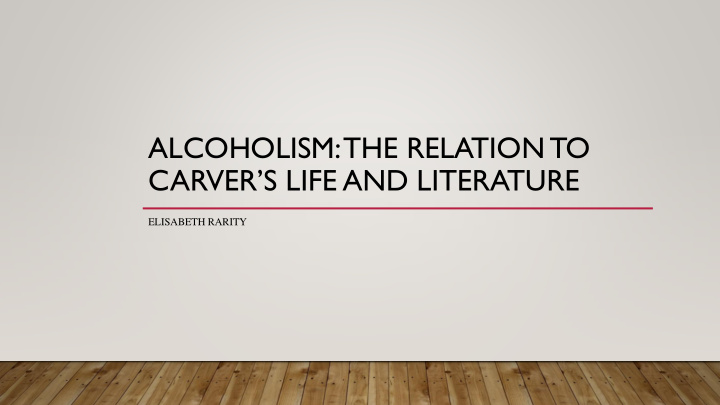



ALCOHOLISM: THE RELATION TO CARVER’S LIFE AND LITERATURE ELISABETH RARITY
STRUGGLE WITH ALCOHOL • Carver began drinking during his first marriage while he was away on a trip with a friend and met another woman • With the help of Alcoholics Anonymous and multiple treatment centers he was able to overcome alcoholism • Carver described the nightmare that was his life before he stopped drinking: It's very painful to think about some of the things that happened back then. … I made a wasteland out of everything I touched. But I might add that towards the end of the drinking there wasn't much left anyway. (Gentry 38, 77)
“CATHEDRAL” • Alcohol (Scotch) and drugs (Marijuana) portrayed in the story: • “She went in and swallowed all the pills and capsules in the medicine cabinet and then washed them down with a bottle of gin.” (pg. 358) • “Right then my wife filled me in with more details than I cared to know. I made a drink and sat at the table to listen.” (pg. 359) • “Every night I smoked dope and stayed up as long as I could before I fell asleep.” (pg. 368)
“CATHEDRAL” (CONT.) • The more alcohol was consumed by the characters, the less focus the story had • Carver wrote ‘Cathedral’ after he had gone through treatment to deal with his alcoholism, but the story shows his struggle of coping with his new cleanness • Alcohol is what allowed the narrator and Robert to form a bond. They were able to talk about Scotch and how they prepared/drank it
“VITAMINS” • Scotch was also consumed, However, the story does not approach the theme of alcoholism directly, but it was referenced. • “I sat at the table with a drink until it began to get light out” (pg. 247) • "It was a nothing job. I did some work, signed the card for eight hours, went drinking with the nurses“ (pg. 245) • “Drinking Scotch and milk with a sliver of ice." "I finished my drink," he says, "and thought about fixing another one. I fixed it“ (pg. 247 & 249)
“VITAMINS” (CONT.) • Alcohol was used as a way to mask the narrator’s unhappiness with multiple aspects of his life. Mainly because his wife was unhappy with his drinking and it was taking a toll on their relationship which led him to have “the hots for Donna.” (pg. 249) More importantly, the narrator’s namelessness reflects his self -alienation which makes • him less of a person, and thus distances him from other people and shows this through his repeated and unself-conscious references to alcohol
CONCLUSION • Carver ties the major theme of alcohol into his stories as it was a theme of his life • Alcohol was used as a coping mechanism
WORKS CITED • Messer, H.Collin . “Fleeing the Wasteland of Alcoholism: Alienation, Recovery, and Hope in Raymond Carver’s Cathedral.” Studies in Short Fiction, vol. 37, no. 1, Winter 2012, pp. 43– 58. EBSCOhost. • Gentry, Marshall Bruce and William L. Stull, eds. Conversations with Raymond Carver. Jackson: UP of Mississippi, 1990.
Recommend
More recommend